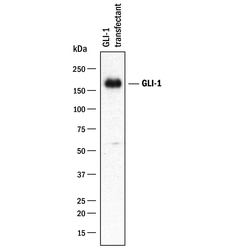Antibody data
- Antibody Data
- Antigen structure
- References [4]
- Comments [0]
- Validations
- Western blot [1]
- Immunocytochemistry [1]
Submit
Validation data
Reference
Comment
Report error
- Product number
- AF3455 - Provider product page

- Provider
- R&D Systems
- Product name
- Human/Mouse GLI-1 Antibody
- Antibody type
- Polyclonal
- Description
- Antigen Affinity-purified. Detects human and mouse GLI-1.
- Reactivity
- Human, Mouse
- Host
- Goat
- Conjugate
- Unconjugated
- Antigen sequence
P47806- Isotype
- IgG
- Vial size
- 100 ug
- Concentration
- LYOPH
- Storage
- Use a manual defrost freezer and avoid repeated freeze-thaw cycles. 12 months from date of receipt, -20 to -70 °C as supplied. 1 month, 2 to 8 °C under sterile conditions after reconstitution. 6 months, -20 to -70 °C under sterile conditions after reconstitution.
Submitted references Multicolor quantitative confocal imaging cytometry.
Mechanism of inhibition of the tumor suppressor Patched by Sonic Hedgehog.
The hedgehog system machinery controls transforming growth factor-β-dependent myofibroblastic differentiation in humans: involvement in idiopathic pulmonary fibrosis.
A novel synthetic smoothened antagonist transiently inhibits pancreatic adenocarcinoma xenografts in a mouse model.
Coutu DL, Kokkaliaris KD, Kunz L, Schroeder T
Nature methods 2018 Jan;15(1):39-46
Nature methods 2018 Jan;15(1):39-46
Mechanism of inhibition of the tumor suppressor Patched by Sonic Hedgehog.
Tukachinsky H, Petrov K, Watanabe M, Salic A
Proceedings of the National Academy of Sciences of the United States of America 2016 Oct 4;113(40):E5866-E5875
Proceedings of the National Academy of Sciences of the United States of America 2016 Oct 4;113(40):E5866-E5875
The hedgehog system machinery controls transforming growth factor-β-dependent myofibroblastic differentiation in humans: involvement in idiopathic pulmonary fibrosis.
Cigna N, Farrokhi Moshai E, Brayer S, Marchal-Somme J, Wémeau-Stervinou L, Fabre A, Mal H, Lesèche G, Dehoux M, Soler P, Crestani B, Mailleux AA
The American journal of pathology 2012 Dec;181(6):2126-37
The American journal of pathology 2012 Dec;181(6):2126-37
A novel synthetic smoothened antagonist transiently inhibits pancreatic adenocarcinoma xenografts in a mouse model.
Strand MF, Wilson SR, Dembinski JL, Holsworth DD, Khvat A, Okun I, Petersen D, Krauss S
PloS one 2011;6(6):e19904
PloS one 2011;6(6):e19904
No comments: Submit comment
Supportive validation
- Submitted by
- R&D Systems (provider)
- Main image

- Experimental details
- Detection of Human GLI-1 by Western Blot. Western blot shows lysates of HEK293 human embryonic kidney cell line transfected with human GLI-1. PVDF membrane was probed with 1 µg/mL of Goat Anti-Human/Mouse GLI-1 Antigen Affinity-purified Polyclonal Antibody (Catalog # AF3455) followed by HRP-conjugated Anti-Goat IgG Secondary Antibody (Catalog # HAF017). A specific band was detected for GLI-1 at approximately 165 kDa (as indicated). This experiment was conducted under reducing conditions and using Immunoblot Buffer Group 1.
Supportive validation
- Submitted by
- R&D Systems (provider)
- Main image

- Experimental details
- GLI-1 in HeLa Human Cell Line. GLI-1 was detected in immersion fixed HeLa human cervical epithelial carcinoma cell line using 10 µg/mL Goat Anti-Human/Mouse GLI-1 Antigen Affinity-purified Polyclonal Antibody (Catalog # AF3455) for 3 hours at room temperature. Cells were stained with the NorthernLights™ 557-conjugated Anti-Goat IgG Secondary Antibody (red; Catalog # NL001) and counterstained with DAPI (blue). View our protocol for Fluorescent ICC Staining of Cells on Coverslips.
 Explore
Explore Validate
Validate Learn
Learn Western blot
Western blot